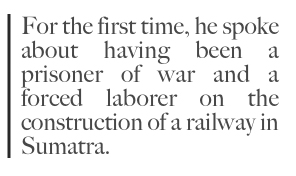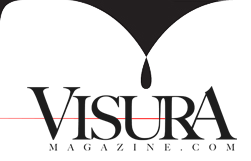
My parents were born during the early 1920’s in the Dutch East Indies, a colony that became modern Indonesia following World War II. My mother was sixteen and my father was twenty years old when the War began, which abruptly shattered their happy and prosperous youth, leaving an indelible impression.
Prosperity and privacy quickly became a thing of the past. Their families were separated and scattered throughout camps that were divided between those for men, women, and boys (10 years old and above), often without any knowledge of each other’s fate. Freedom and security were replaced by the grim bondage of, in my father’s case, slave labor. For my mother, it meant life in an internment camp, facing hunger, disease and the threat of being taken in as a comfort woman—a forced prostitute for the Japanese armed forces.
They survived, unlike many others. Still, the end of the war did not bring peace. Like a great number of Dutch living in the Dutch East Indies, my parents were forced to leave their country during the Indonesian War of Independence (1945-1949). They fled to The Netherlands, for them a cold and alien country.
For as long as I can remember, I was at least vaguely aware that my parents were from somewhere else. I cannot quite recall when I first learned about my parents’ Indies past. In the company of old friends, they would suddenly begin to utter exotic sounds, drop mysterious names, and start rolling their Rs. Conversations not meant for small ears were conducted in Malay. As children, we learned a smattering of Malay words that lost their meaning the moment we stepped outside the house. Since we did not have any roots in the Netherlands, our family moved all over the place.
My parents’ past was a topic of interest throughout my childhood. There were times when my mother spoke about living in the internment camps but only shared funny or light-hearted stories. It was not until I was older did she become more explicit on the subject. My father never spoke about his life as a POW until I was much older.

My father slowly began to open up around the time he retired. For the first time, he spoke about having been a prisoner of war and a forced laborer on the construction of The Sumatra Railway. He also vaguely referred to his father, who had also been a forced laborer on the Burma Railway. Despite of the similarities of their fate, my grandfather never spoke about his time as a slave worker.
My father also mentioned the fate of the romushas, the forced civilian laborers of Asian extraction. A staggering percentage of the hundreds of thousands of romushas who had worked on these railroads died as a result of their enslavement; sadly, they were buried in unmarked graves or thrown out like trash, leaving very little to say about the Japanese army propaganda about a War for Asian Liberation.
As years passed, my parents’ war was securely embedded in my consciousness, not as a burden but simply as an influence, and, quite possibly, an addition to my overall wisdom. They emerged from that period relatively unscathed, perhaps, in part, because neither of them lost any family. Homesickness seemed to be their biggest heartache. Yet, I became aware of the painful silence that many of their peers maintained, including my own grandfather, whose silence was a sharp contrast to that of my outspoken father. I wondered, what could had been on my taciturn granddad’s mind?
I titled the project Traces of War: Survivors of the Burma and Sumatra Railways (TrolleyBooks, 2005). I photographed these men, both the POWS and the Romushas without a shirt on. Photographing them shirtless was a representation of the attire they wore constructing the railways, a time when they were only allowed to wear a tjawat, a small loincloth and nothing else. Now in their eighties and nineties, I took individual portraits of them.
POWs and Asian male citizens were not the only ones used as slave laborers. Possibly the most gruesome, and certainly the most hidden aspect of female forced labor were Comfort Women, girls forced to become prostitutes for the Japanese armed forces in the occupied Asian countries of China, Taiwan, Korea, the Philippines and Indonesia.
After losing one-fourth to one-third of its army to venereal diseases during the Siberian Intervention 1918-1922, the Japanese military authorities decided that in their future wars, they had to protect their military personnel from such a risk. The solution was to create Comfort Stations: brothels for soldiers, which offered at least in theory, the use of condoms and regular medical check-ups of the women working there, to protect their military.
There were very few women who volunteered to be prostitutes. As a result, an estimated 200,000 Chinese, Korean, Philippine, Indonesian and colonial Dutch girls were abducted and recruited under false pretexts, to serve the Japanese soldiers’ sexual needs. Consequently, other Japanese army units unsuccessfully attempted to set up similar institutes in hotels or private houses; they forced local girls, sometimes as young as 10 or 11 years old, to be their private mistress. According to estimates, only 25 percent of the female victims survived, of which many were unable to have children as a consequence from being raped or having been infected with a disease.
Many were considered to have brought shame to their families and communities; they were stigmatized and cast out. Understandably, they tried to hide their wartime history, often even from their parents. For years, the subject stayed underground. In the early 1990s, the phenomenon came to light but only a handful of women shared their stories.
A few years after finishing Traces of War, I felt the urge to start a new project about these female forced laborers. Coincidentally, my good friend Hilde Janssen, Dutch anthropologist and newspaper correspondent in Jakarta, with a 20-year experience in the Far East and fluent in Indonesian, also wanted to investigate this subject. After a search that lasted several years, she managed to find 50 (of an estimated total of 20,000) former Indonesian Comfort Women who were willing to be interviewed and portrayed. These women lived all over the archipelago, from West Java and Northern Sumatra to the extremely inaccessible Moluccan island of Babar. In almost all cases, our meetings had to be held in hotel rooms or on other “neutral grounds” for the women’s families, often including their husbands, knew nothing or very little about their wartime ordeals.
What convinced these now elder women to participate in this project was the fact that they were aging and many possibly approaching death. In their perspective, by sharing their truth and telling their story, each of these women were giving a sense of purpose to their life-long sufferings and traumatic events. In addition, they participated with the hope that they would receive an apology and compensation from the Japanese and Indonesian governments. For Hilde and me, the relevance of exposing this subject was an attempt to contribute to justice for the Comfort Women. Raping women seems to be a normal byproduct of wars and many of these women have suffered physical and emotional consequences ever since.
In the series Comfort Women, eighteen women break the silence and expose the reality of their existence. Comfort Women existed and this project is its testimony. By depicting these portraits of real individuals juxtaposed to Japanese war posters, we present male and female sides of war, propaganda versus reality. Alongside these portraits are short narratives that depict the fate of these men and former comfort women, meanwhile painting a gripping picture of this hidden history.
What started as a personal investigation into the history of my parents extended to their contemporaries and became something more universal: a social documentary case study into the long-term consequences of war and exploitation.
www.janbanning.com





